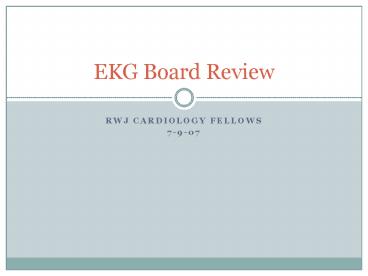RWJ Cardiology Fellows PowerPoint PPT Presentation
1 / 12
Title: RWJ Cardiology Fellows
1
EKG Board Review
- RWJ Cardiology Fellows
- 7-9-07
2
3 Types of RVH
- 1) Typical RVH pattern
- 2) Incomplete RBBB
- 3) Posterior and rightward displacement of QRS
axis
3
Typical RVH Pattern
- 1) Tall R wave in V1 (gt0.7 mV)
- 2) Right axis deviation (gt110º)
- 3) T wave inversion in V1 through V3
- 4) Delayed precordial transition zone (rS in V6)
- 5) Right atrial abnormality
4
Typical RVH Pattern
- Differential Diagnosis
- RV pressure overload
- True posterior wall MI
- Type A WPW
- RBBB
- Dextrocardia
- Lead misplacement
- Normal young adults
5
Typical RVH Pattern
- QRS Patterns
- 1) qR pattern in Lead V1 most specific sign of
severe RVH - 2) S1S2S3 pattern
- Seen in normal pts, emphysema, or RVH
- R/S ratio 1 in lease I, II, and III
- 3) S1Q3T3 pattern
- S wave in lead I (as an RS or rS complex)
- Abnormal Q wave in lead III
- Inverted T wave in the inferior leads
6
(No Transcript)
7
Incomplete RBBB
- Due to delayed activation of the hypertrophied RV
outflow tract - Differential Diagnosis
- 1) Normal individuals
- 2) Acute RV dilatation
- 3) True posterior MI
- 4) Extracardiac abnormalities (pectus excavatum)
- 5) RV overload (ex. Pulmonary HTN, ASD)
- Pattern disappears within days of corrective
surgery suggesting slowing of intraventricular
conduction due to stretching of peripheral
conducting system in dilated RV
8
Patterns in Chronic Lung Disease
- Due to changes in the spatial orientation of the
heart and the insulating effect of the
overaerated lungs - Patterns
- 1) Peaked p waves in II, III, aVF
- 2) Low R wave amplitude in all leads
- 3) Slurred S wave in I, II, III, V4, V5, and V6
- 4) Right axis deviation in the frontal plane
- 5) Delayed transition in the precordial leads
9
Pulmonary emphysema simulating anterior
infarction in a 58-year-old man with no clinical
evidence of coronary disease. Note the relative
normalization of R wave progression with
placement of the chest leads an interspace below
their usual position (5V1, 5V2, and so forth).
10
RVH in Other Clinical Conditions
- Pulmonary Hypertension in Mitral Stenosis
- Rhythm is usually sinus tachycardia
- EKG often shows incomplete right bundle branch
block - Usually occurs when PAP 42mmHg
- Left atrial abnormality (enlargement) indicated
by prominent biphasic P wave in lead V1 - Frequently see concomitant right atrial
enlargement (biatrial abnormality) as indicated
by Tall P wave in lead II - Nonspecific ST-T changes
- Combination of right ventricular hypertrophy and
left atrial abnormality (enlargement) is highly
suggestive of mitral stenosis
11
45-year-old woman with severe mitral stenosis
shows multiple abnormalities.
12
RVH in Other Clinical Conditions
- Atrial Septal Defect

